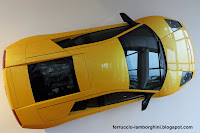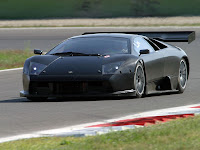Lamborghini Motorcycles
Model 1986, 1000 cc, 130 HP, 256 km/h

The Lamborghini Motorbike was designed in 1984-85 as a result of a close collaboration between Lamborghini and the French leading-edge racing bike constructor Boxer-Bike.
Boxer Bike has been famous since the seventies for their sophisticated racing bikes: hand-built in Toulouse (the French Aircraft and Aerospace Valley) with extensive use of aerospace-technology, ultra lightweight frames theses motorbikes offered the highest performance.
In 1986, in search of expansion and diversity, Lamborghini decided that a motorbike would bear their name. Boxer was the only partner capable of building the ambitious, ultra-expensive Lamborghini Design 90, powered by a state-of-the-art, 4-cam, 4 valve per cylinder straight-4 Kawasaki engine.

 The price was twice as high as the most famous high-end motorbike of the period. This outrageous price factor, in addition to the extremely limited series - Lamborghini announced that 20 to 25 would be built, but only a handful were actually completed - contributed to establish the myth of the Lamborghini bike. Chief Engineer for this bike was Claude Fior, famous for his unique high-tech racing bikes. Fior unfortunately died young a few years ago in aircraft accident.
The price was twice as high as the most famous high-end motorbike of the period. This outrageous price factor, in addition to the extremely limited series - Lamborghini announced that 20 to 25 would be built, but only a handful were actually completed - contributed to establish the myth of the Lamborghini bike. Chief Engineer for this bike was Claude Fior, famous for his unique high-tech racing bikes. Fior unfortunately died young a few years ago in aircraft accident.



Lamborghini Caramelo, V4, 1000 cc
 Designed by romanian Laurentiu Trifescu, who imagined how a Lamborghini superbike could look like if the Italian supercar maker would ever consider producing one.
Designed by romanian Laurentiu Trifescu, who imagined how a Lamborghini superbike could look like if the Italian supercar maker would ever consider producing one. The name Caramelo comes, like in the case of most Lambo products, from a famous Spanish bull. This defeated a lion and a tiger in the Madrid arena in 1877. The animal’s courage and strength impressed the audience so much that they yelled for it to be spared and his name is remembered to this day.
Following the true Italian spirit, the Caramelo is supposed to be a superbike built on a tubular steel frame with single-sided swingarm and powered by a powerful 1000cc V4 engine. The design meets the edge style of the Murcielago and Gallardo and it is characterized by angular lines and cleaner surfaces.
Frenchman Spends 10 Years Building Lamborghini Motorcycle Sidecar
A 45 years old French medical technician, François Knorreck, has spent ten years and $22,000 building the ultimate luxury sidecar: a motorcycle seamlessly attached to a Lamborghini body.
The 877 pound vehicle can go up to 125 mph and took 63 handmade bodywork molds to build. “The part that I’m most proud of is the bodywork,” Knorreck says. “Not the design, but the high level of finishing.”

Red Hot The sidecar’s design is inspired by the look of a Lamborghini and the McLaren F1, and the color is a tribute to Ferrari. Philippe Rony Photography
In 1989, François Knorreck took a long ride in the sidecar of a friend’s motorcycle and enjoyed it so much that he decided to build a rig of his own. Now, 20 years, 63 bodywork molds and innumerable headaches later, he has it: a handcrafted masterpiece that’s part motorcycle, part Lamborghini.
Knorreck, a 45-year-old French medical technician, started by sketching pencil designs and then built a full-size wooden model. He had worked on motorcycles in the past, but figuring out how to distribute the sidecar’s weight and where to position its single wheel were wholly new challenges. After determining the dimensions, he machined an aluminum chassis and moved the sidecar’s wheel forward to keep the vehicle stable and prevent it from veering. He also had to beef up the motorcycle’s headstock bearing—a piece of the steering column that bears most of the sidecar’s weight.
At the motorcycle’s controls, Knorreck has pushed the vehicle to 125 miles an hour, near its estimated top speed, but never intends to fully open it up. After all, he says, despite the sidecar’s looks, it’s only along for the ride.

Hop In: The sole door opens Lamborghini-style, driven by an electric motor. Philippe Rony Photography
How the Real Life Lunar Lander Recplica Works
Time: Ten years
Cost: $22,000

An Artistic Masterpiece : “The part that I’m most proud of is the bodywork,” Knorreck says. “Not the design, but the high level of finishing.” Philippe Rony Photography
The sidecar isn’t merely welded to the motorcycle—the two are seamlessly linked, from the chassis to the wiring to the carbon-fiber, hand-crafted body. Getting the two pieces to work in concert was no easy feat. With the sidecar’s wheel positioned too far forward or back, the off-kilter weight distribution could cause the bike and sidecar to roll forward and to the right. (Errors distributing the vehicle’s 877 pounds could also put excess strain on the frame, leading to structural cracks.) To remedy these problems, Knorreck built an adjustable aluminum chassis so he could tinker with the wheelbase and other elements to see what worked best before adding interior parts. He found that moving the sidecar’s wheel forward just enough, relative to the motorcycle’s rear one, provided additional stability and ensured a straight ride. FUEL
The original motorcycle had a gravity-fed system in which the fuel ran down to the carburetors from above. But Knorreck found that he had to relocate the tank and place it underneath the body of the sidecar. Then he added an electrical pump to route the fuel to the engine.
COMFORT
Knorreck built the entire frame and body of the sidecar (he had to make 63 different molds by hand to create its various carbon-fiber panels), but he’s no upholsterer, so he had a friend custom-manufacture the seats. Just in case tooling around in a freakishly cool sidecar wasn’t enough for his passengers (it can seat two at a time), he installed a stereo system. For that, however, he kept costs to a minimum, using an old radio from his father.

 The Lamborghini Aventador LP700-4 is a two-door, two-seater sports car publicly unveiled by Lamborghini at the Geneva Motor Show on 28 February 2011, five months after its initial unveiling in Sant'Agata Bolognese. Internally codenamed LB834,[3] the Aventador was designed to replace the ten-year-old Murciélago as the new flagship model in the Lamborghini line-up starting in 2011. Soon after the Aventador unveiling, Lamborghini announced that it had already sold over 12 months of the production vehicles, with deliveries starting in the second half of 2011. The suggested retail price is €255,000 in Europe, £201,900 in the UK and $379,700 in the U.S
The Lamborghini Aventador LP700-4 is a two-door, two-seater sports car publicly unveiled by Lamborghini at the Geneva Motor Show on 28 February 2011, five months after its initial unveiling in Sant'Agata Bolognese. Internally codenamed LB834,[3] the Aventador was designed to replace the ten-year-old Murciélago as the new flagship model in the Lamborghini line-up starting in 2011. Soon after the Aventador unveiling, Lamborghini announced that it had already sold over 12 months of the production vehicles, with deliveries starting in the second half of 2011. The suggested retail price is €255,000 in Europe, £201,900 in the UK and $379,700 in the U.S Like previous Lamborghinis, the Aventador name was chosen for its symbolic connection to the world of fighting bulls, sharing a name with the legendary Aventador, a trophy-winning bull in the world of Spanish bullfighting. Bred by the sons of Don Celestino Cuadri Vides, the bull that bore the number 32 took part in a notably spirited, bloody and violent battle with a torero in the town of Zaragoza, Spain that earned him the “Trofeo de la Peña La Madroñera" in 1993.
Like previous Lamborghinis, the Aventador name was chosen for its symbolic connection to the world of fighting bulls, sharing a name with the legendary Aventador, a trophy-winning bull in the world of Spanish bullfighting. Bred by the sons of Don Celestino Cuadri Vides, the bull that bore the number 32 took part in a notably spirited, bloody and violent battle with a torero in the town of Zaragoza, Spain that earned him the “Trofeo de la Peña La Madroñera" in 1993.
 Performance is estimated to be 0–100 km/h (62 mph) in 2.9 seconds with a top speed of around 349 km/h (217 mph). Its United States Environmental Protection Agency fuel mileage is 14 miles per US gallon (17 L/100 km; 17 mpg-imp).
Performance is estimated to be 0–100 km/h (62 mph) in 2.9 seconds with a top speed of around 349 km/h (217 mph). Its United States Environmental Protection Agency fuel mileage is 14 miles per US gallon (17 L/100 km; 17 mpg-imp).




























































